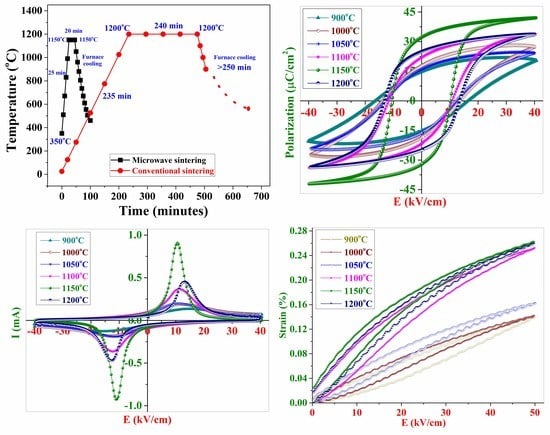Investigation of the Effects of Reduced Sintering Temperature on Dielectric, Ferroelectric and Energy Storage Properties of Microwave-Sintered PLZT 8/60/40 Ceramics
Abstract
1. Introduction
2. Experimental Procedure
3. Results and Discussion
3.1. Temperature-Dependent Dielectric Properties of PLZT 8/60/40 Ceramics
3.2. Polarization Versus Electric Field Ferroelectric Hysteresis Loops
3.3. Domain Switching in Current versus Electric Field Loops
3.4. Energy Storage Properties of Microwave-Sintered PLZT 8/60/40 Ceramics
3.5. Strain versus Electric Field (S-E) Hysteresis Loops
4. Conclusions
Author Contributions
Funding
Acknowledgments
Conflicts of Interest
References
- Haertling, G.H. Ferroelectric ceramics: History and technology. J. Am. Ceram. Soc. 1999, 82, 797–818. [Google Scholar] [CrossRef]
- Uchino, K. Ferroelectric Devices; Marcel Dekker Inc.: New York, NY, USA, 2000. [Google Scholar]
- Uchino, K. Materials issues in design and performance of piezoelectric actuators: An overview. Acta Mater. 1998, 46, 3745–3753. [Google Scholar] [CrossRef]
- Hu, Z.; Ma, B.; Liu, S.; Narayanan, M.; Balachandran, U. Relaxor behavior and energy storage performance of ferroelectric PLZT thin films with different Zr/Ti ratios. Ceram. Int. 2014, 40, 557–562. [Google Scholar] [CrossRef]
- Kumar, A.; Kim, S.H.; Peddigari, M.; Jeong, D.-H.; Hwang, G.-T.; Ryu, J. High energy storage properties and electrical field stability of energy efficiency of (Pb0.89La0.11)(Zr0.70Ti0.30)0.9725O3 relaxor ferroelectric ceramics. Electron. Mater. Lett. 2019, 15, 323–330. [Google Scholar] [CrossRef]
- Thakre, A.; Kumar, A.; Jeong, D.Y.; Hwang, G.T.; Yoon, W.H.; Lee, H.Y.; Ryu, J. Enhanced mechanical quality factor of 32 mode Mn doped 71Pb(Mg1/3Nb2/3)O3–29PbZrTiO3 piezoelectric single crystals. Electron. Mater. Lett. 2020, 16, 156–163. [Google Scholar] [CrossRef]
- Lu, Y.; Chen, J.; Cheng, Z.; Zhang, S. The PZT/Ni unimorph magnetoelectric energy harvester for wireless sensing applications. Energy Convers. Manag. 2019, 200, 112084. [Google Scholar] [CrossRef]
- Maiwa, H.; Jia, T.; Kimura, H. Energy harvesting using PLZT and lead-free ceramics and their piezoelectric properties on the nano-scale. Ferroelectrics 2015, 475, 71–81. [Google Scholar] [CrossRef]
- Gupta, R.; Tomar, M.; Kumar, A.; Gupta, V. Performance of magnetoelectric PZT/Ni multiferroic system for energy harvesting application. Smart Mater. Struct. 2017, 26, 035002. [Google Scholar] [CrossRef]
- Xu, T.B.; Siochi, E.J.; Kang, J.H.; Zuo, L.; Zhou, W.; Tang, X.; Jiang, X. Energy harvesting using a PZT ceramic multilayer stack. Smart Mater. Struct. 2013, 22, 065015. [Google Scholar] [CrossRef]
- Maiwa, H. Thermal energy harvesting of PLZT and BaTiO3 ceramics using pyroelectric effects. In Nanoscale Ferroelectric-Multiferroic Materials for Energy Harvesting Applications; Elsevier: Amsterdam, The Netherlands, 2019; pp. 217–229. ISBN 9780128145005. [Google Scholar]
- Lee, F.Y.; Jo, H.R.; Lynch, C.S.; Pilon, L. Pyroelectric energy conversion using PLZT ceramics and the ferroelectric-ergodic relaxor phase transition. Smart Mater. Struct. 2013, 22, 025038. [Google Scholar] [CrossRef]
- James, A.R.; Kumar, A. Development of PLZT electroceramics with ultrahigh piezoelectric properties by a novel material engineering approach. In Handbook of Advanced Ceramics and Composites; Mahajan, Y.R., Johnson, R., Eds.; Springer International Publishing: Cham, Switzerland, 2019; pp. 215–250. [Google Scholar]
- Kumar, A.; Thakre, A.; Jeong, D.-Y.; Ryu, J. Prospects and challenges of the electrocaloric phenomenon in ferroelectric ceramics. J. Mater. Chem. C 2019, 7, 6836–6859. [Google Scholar] [CrossRef]
- Liu, K.; Wang, W.; Liu, Q.; Song, L.; Guo, Y.W.; Ye, F. Photostriction properties of PLZT (4/52/48) ceramics sintered by SPS. Ceram. Int. 2019, 45, 2097–2102. [Google Scholar] [CrossRef]
- Xu, Z.; Zeng, X.; Cao, Z.; Ling, L.; Qiu, P.; He, X. Effects of barium substitution on the optical and electrical properties of PLZT transparent electro-optical ceramics. Ceram. Int. 2019, 45, 17890–17897. [Google Scholar] [CrossRef]
- Pérez-Tomás, A.; Mingorance, A.; Tanenbaum, D.; Lira-Cantú, M. Metal Oxides in photovoltaics: All-oxide, ferroic, and perovskite solar cells. Futur. Semicond. Oxides Next Gener. Sol. Cells 2018, 267–356. [Google Scholar]
- Ichiki, M.; Morikawa, Y.; Nakada, T.; Maeda, R. Photovoltaic properties of lead lanthanum zirconate titanate ceramics in a layered film structure design. Ceram. Int. 2004, 30, 1831–1834. [Google Scholar] [CrossRef]
- Thakre, A.; Kumar, A.; Song, H.-C.; Jeong, D.-Y.; Ryu, J. Pyroelectric energy conversion and its applications—Flexible energy harvesters and sensors. Sensors 2019, 19, 2170. [Google Scholar] [CrossRef]
- Kong, L.; Zhu, W.; Tan, O. Preparation and characterization of Pb(Zr0.52Ti0.48)O3 ceramics from high-energy ball milling powders. Mater. Lett. 2000, 42, 232–239. [Google Scholar] [CrossRef]
- Kong, L.; Ma, J.; Zhu, W.; Tan, O. Preparation and characterization of PLZT ceramics using high-energy ball milling. J. Alloys Compd. 2001, 322, 290–297. [Google Scholar] [CrossRef]
- Singhal, C.; Murtaza, Q. Parvej microwave sintering of advanced composites materials: A review. Mater. Today Proc. 2018, 5, 24287–24298. [Google Scholar] [CrossRef]
- Janney, M.A.; Kimrey, H.D. Diffusion-controlled processes in microwave-fired oxide ceramics. Mrs. Proc. 1990, 189, 215. [Google Scholar] [CrossRef]
- Zuo, F.; Saunier, S.; Marinel, S.; Chanin-Lambert, P.; Peillon, N.; Goeuriot, D. Investigation of the mechanism(s) controlling microwave sintering of α-alumina: Influence of the powder parameters on the grain growth, thermodynamics and densification kinetics. J. Eur. Ceram. Soc. 2015, 35, 959–970. [Google Scholar] [CrossRef]
- Gonçalves, M.D.; Souza, F.L.; Longo, E.; Leite, E.R.; Camargo, E.R. Dielectric characterization of microwave sintered lead zirconate titanate ceramics. Ceram. Int. 2016, 42, 14423–14430. [Google Scholar] [CrossRef]
- Gonçalves, M.D.; Camargo, E.R. Lanthanum-doped PZT synthesized by the oxidant peroxide method and sintered by conventional and microwave routes. Ceram. Int. 2017, 43, 3004–3009. [Google Scholar] [CrossRef]
- Fernandez Perdomo, C.P.; Kiminami, R.H.G.A.; Garcia, D. Microwave assisted sintering of nanocristalline PMN-PT/CoFe2O4 prepared by rapid one pot pechini synthesis: Dielectric and magnetoelectric characteristics. Ceram. Int. 2019, 45, 7906–7915. [Google Scholar] [CrossRef]
- Fernández, C.P.; Zabotto, F.L.; Garcia, D.; Kiminami, R.H.G.A. In situ sol–gel co-synthesis under controlled pH and microwave sintering of PZT/CoFe2O4 magnetoelectric composite ceramics. Ceram. Int. 2016, 42, 3239–3249. [Google Scholar] [CrossRef]
- Cai, E.; Liu, Q.; Zeng, F.; Wang, Y.; Xue, A. A comparative study of lead-free (Ba0.85Ca0.15)(Ti0.9Zr0.08Sn0.02)O3 ceramics prepared by conventional sintering and microwave sintering techniques. Ceram. Int. 2018, 44, 788–798. [Google Scholar] [CrossRef]
- Chandrasekhar, M.; Kumar, P. Microwave sintered sol–gel derived BaTiO3 and Ba0.95La0.05TiO3 ceramic samples for capacitor applications. Ceram. Int. 2016, 42, 10587–10592. [Google Scholar]
- Rani, R.; Kumar, P.; Singh, S.; Juneja, J.K.; Raina, K.K.; Prakash, C. Ferroelectric properties of microwave processed PZT-NiZn ferrite composites. Integr. Ferroelectr. 2010, 122, 45–51. [Google Scholar] [CrossRef]
- Vaidhyanathan, B.; Singh, A.P.; Agrawal, D.K.; Shrout, T.R.; Roy, R.; Ganguly, S. Microwave effects in lead zirconium titanate synthesis: Enhanced kinetics and changed mechanisms. J. Am. Ceram. Soc. 2004, 84, 1197–1202. [Google Scholar] [CrossRef]
- Kumar, A.; Yoon, J.Y.; Thakre, A.; Peddigari, M.; Jeong, D.-Y.; Kong, Y.-M.; Ryu, J. Dielectric, ferroelectric, energy storage, and pyroelectric properties of Mn-doped (Pb0.93La0.07)(Zr0.82Ti0.18)O3 anti-ferroelectric ceramics. J. Korean Ceram. Soc. 2019, 56, 412–420. [Google Scholar] [CrossRef]
- Kumar, A.; Bhanu Prasad, V.V.; James Raju, K.C.; James, A.R. Ultra high strain properties of lanthanum substituted PZT electro-ceramics prepared via mechanical activation. J. Alloys Compd. 2014, 599, 53–59. [Google Scholar] [CrossRef]
- Kumar, A.; Reddy Emani, S.; Bhanu Prasad, V.V.; James Raju, K.C.; James, A.R. Microwave sintering of fine grained PLZT 8/60/40 ceramics prepared via high energy mechanical milling. J. Eur. Ceram. Soc. 2016, 36, 2505–2511. [Google Scholar] [CrossRef]
- Kumar, A.; Bhanu Prasad, V.V.; James Raju, K.C.; James, A.R. Optimization of poling parameters of mechanically processed PLZT 8/60/40 ceramics based on dielectric and piezoelectric studies. Eur. Phys. J. B 2015, 88, 287. [Google Scholar] [CrossRef]
- Kumar, A.; Bhanu Prasad, V.V.; James Raju, K.C.; James, A.R. Poling electric field dependent domain switching and piezoelectric properties of mechanically activated (Pb0.92La0.08)(Zr0.60Ti0.40)O3ceramics. J. Mater. Sci. Mater. Electron. 2015, 26, 3757–3765. [Google Scholar] [CrossRef]
- Rajesh, S.; Murali, K.P.; Rajani, K.V.; Ratheesh, R. SrTiO3-filled PTFE composite laminates for microwave substrate applications. Int. J. Appl. Ceram. Technol. 2009, 6, 553–561. [Google Scholar] [CrossRef]
- Penn, S.J.; Alford, N.M.; Templeton, A.; Wang, X.; Xu, M.; Reece, M.; Schrapel, K. Effect of porosity and grain size on the microwave dielectric properties of sintered alumina. J. Am. Ceram. Soc. 2005, 80, 1885–1888. [Google Scholar] [CrossRef]
- Sindam, B.; James Raju, K.C. Influence of sintering temperature on microwave dielectric properties, structure and lattice modes of Ba(Zn1/3Ta2/3)O3 resonators. J. Mater. Sci. Mater. Electron. 2015, 26, 3997–4004. [Google Scholar] [CrossRef]
- Uchino, K.; Nomura, S. Critical exponents of the dielectric constants in diffused-phase-transition crystals. Ferroelectrics 1982, 44, 55–61. [Google Scholar] [CrossRef]
- Kumar, A.; James Raju, K.C.; James, A.R. Diffuse phase transition in mechanically activated (Pb1−xLax)(Zr0.60Ti0.40)O3 electro-ceramics. J. Mater. Sci. Mater. Electron. 2017, 28, 13928–13936. [Google Scholar] [CrossRef]
- Jin, L.W.; Su, Y. Effect of thermomechanical coupling on the scaling behavior of low-frequency hysteresis of PbZr0.52Ti0.48O3 ceramics. Electron. Mater. Lett. 2016, 12, 371–375. [Google Scholar] [CrossRef]
- Namsar, O.; Pojprapai, S.; Watcharapasorn, A.; Jiansirisomboon, S. Polarization fatigue in ferroelectric Pb(Zr0.52Ti0.48)O3-SrBi2Nb2O9 ceramics. Electron. Mater. Lett. 2015, 11, 881–889. [Google Scholar] [CrossRef]
- Tian, Y.; Chao, X.; Wei, L.; Liang, P.; Yang, Z. Phase transition behavior and electrical properties of lead-free (Ba1−xCax)(Zr0.1Ti0.9)O3 piezoelectric ceramics. J. Appl. Phys. 2013, 113, 184107. [Google Scholar] [CrossRef]
- Damjanovic, D. Ferroelectric, dielectric and piezoelectric properties of ferroelectric thin films and ceramics. Rep. Prog. Phys. 1998, 61, 1267–1324. [Google Scholar] [CrossRef]
- Scott, J.F.; Kammerdiner, L.; Parris, M.; Traynor, S.; Ottenbacher, V.; Shawabkeh, A.; Oliver, W.F. Switching kinetics of lead zirconate titanate submicron thin-film memories. J. Appl. Phys. 1988, 64, 787–792. [Google Scholar] [CrossRef]
- Jiang, A.Q.; Lee, H.J.; Hwang, C.S.; Scott, J.F. Sub-picosecond processes of ferroelectric domain switching from field and temperature experiments. Adv. Funct. Mater. 2012, 22, 192–199. [Google Scholar] [CrossRef]
- Merz, W.J. Domain formation and domain wall motions in ferroelectric BaTiO3, single crystals. Phys. Rev. 1954, 95, 690–698. [Google Scholar] [CrossRef]
- Kamel, T.M.; Kools, F.X.N.M.; de With, G. Poling of soft piezoceramic PZT. J. Eur. Ceram. Soc. 2007, 27, 2471–2479. [Google Scholar] [CrossRef]
- Fatuzzo, E.; Merz, W.J. Switching mechanism in triglycine sulfate and other ferroelectrics. Phys. Rev. 1959, 116, 61–68. [Google Scholar] [CrossRef]
- Pulvari, C.F.; Kuebler, W. Phenomenological theory of polarization reversal in BaTiO3 single crystals. J. Appl. Phys. 1958, 29, 1315–1321. [Google Scholar] [CrossRef]
- Li, F.; Zhai, J.; Shen, B.; Liu, X.; Zeng, H. Simultaneously high-energy storage density and responsivity in quasi-hysteresis-free Mn-doped Bi0.5Na0.5TiO3-BaTiO3-(Sr0.7Bi0.2□0.1)TiO3 ergodic relaxor ceramics. Mater. Res. Lett. 2018, 6, 345–352. [Google Scholar] [CrossRef]
- Arif, S.; Saba, S.; Mustafa, G.M.; Akhtar, M.; Saleem, M.; Riaz, S.; Atiq, S. Analysis of recoverable and energy loss density mediated by Ni/Cr co-doping in BiFeO3. J. Mater. Sci. Mater. Electron. 2020, 31, 14775–14783. [Google Scholar] [CrossRef]
- Samanta, S.; Sankaranarayanan, V.; Sethupathi, K. Effect of Nb and Fe co-doping on microstructure, dielectric response, ferroelectricity and energy storage density of PLZT. J. Mater. Sci. Mater. Electron. 2018, 29, 20383–20394. [Google Scholar] [CrossRef]
- Samanta, S.; Sankaranarayanan, V.; Sethupathi, K. Temperature dependence of energy storage density and differential permittivity and bandgap study of relaxor (Pb,La)Zr0.65Ti0.35O3. Integr. Ferroelectr. 2019, 202, 153–162. [Google Scholar] [CrossRef]
- Ciuchi, I.V.; Mitoseriu, L.; Galassi, C. Antiferroelectric to ferroelectric crossover and energy storage properties of (Pb1− xLax)(Zr0.90Ti0.10)1−x/4O3 (0.02 ≤ x ≤ 0.04) ceramics. J. Am. Ceram. Soc. 2016, 99, 2382–2387. [Google Scholar] [CrossRef]
- Kumar, A.; James Raju, K.C.; Ryu, J.; James, A.R. Composition dependent ferro-piezo hysteresis loops and energy density properties of mechanically activated (Pb1−xLax)(Zr0.60Ti0.40)O3 ceramics. Appl. Phys. A Mater. Sci. Process. 2020, 126, 1–10. [Google Scholar] [CrossRef]
- Eriksson, M.; Yan, H.; Viola, G.; Ning, H.; Gruner, D.; Nygren, M.; Reece, M.J.; Shen, Z. Ferroelectric domain structures and electrical properties of fine-grained lead-free sodium potassium niobate ceramics. J. Am. Ceram. Soc. 2011, 94, 3391–3396. [Google Scholar] [CrossRef]
- Hoffmann, M.J.; Hammer, M.; Endriss, A.; Lupascu, D.C. Correlation between microstructure, strain behavior, and acoustic emission of soft PZT ceramics. Acta Mater. 2001, 49, 1301–1310. [Google Scholar] [CrossRef]
- Cao, W.; Randall, C.A. Grain size and domain size relations in bulk ceramic ferroelectric materials. J. Phys. Chem. Solids 1996, 57, 1499–1505. [Google Scholar] [CrossRef]
- Arlt, G.; Hennings, D.; De With, G. Dielectric properties of fine-grained barium titanate ceramics. J. Appl. Phys. 1985, 58, 1619–1625. [Google Scholar] [CrossRef]
- Tuttle, B.A.; Garino, T.J.; Voigt, J.A.; Headley, T.J.; Dimos, D.; Eatough, M.O. Relationships between ferroelectric 90° domain formation and electrical properties of chemically prepared Pb(Zr,Ti)O3 thin films. In Proceedings of the NATO Advanced Research Workshop on Science and Technology of Electroceramic Thin Films, Villa Del Mare, Italy, 20–24 June 1994. [Google Scholar]
- Jung, S.-C.; Park, H.-B.; Kim, J.; Kim, K.; Kim, S.-J. Structure and electric properties of PZT ceramics substituted by La and Nd. J. Korean Ceram. Soc. 1994, 31, 155–160. [Google Scholar]
- Dutta, S.; Choudhary, R.N.; Sinha, P. Structural, dielectric and electrical properties of Al+3-modified PLZT ceramics. Mater. Lett. 2004, 58, 2735–2740. [Google Scholar] [CrossRef]
- Dutta, S.; Choudhary, R.N.P.; Sinha, P.K. Structural, dielectric and piezoelectric properties of aluminium doped PLZT ceramics prepared by sol–gel route. J. Alloys Compd. 2007, 430, 344–349. [Google Scholar] [CrossRef]
- Shannigrahi, S.R.; Tay, F.E.H.; Yao, K.; Choudhary, R.N.P. Effect of rare earth (La, Nd, Sm, Eu, Gd, Dy, Er and Yb) ion substitutions on the microstructural and electrical properties of sol-gel grown PZT ceramics. J. Eur. Ceram. Soc. 2004, 24, 163–170. [Google Scholar] [CrossRef]
- Thakur, O.P.; Prakash, C. Structural, dielectric and piezoelectric properties of PLZT (x/60/40) ceramics. Integr. Ferroelectr. 2010, 122, 100–107. [Google Scholar] [CrossRef]
- García-Zaldívar, O.; Peláiz-Barranco, A.; Guerra, J.D.S.; Mendoza, M.E.; Calderón-Piñar, F.; Hall, D.A. Influence of the A and B vacancies on the dielectric and structural properties of the PLZT 8/60/40 ferroelectric ceramic system. Phys. B Condens. Matter 2011, 406, 1622–1626. [Google Scholar] [CrossRef]
- Shannigrahi, S.R.; Choudhary, R.N.P. Structural and dielectric properties of Sol-Gel derived PLZT (x/60/40). J. Electroceramics 2000, 5, 201–209. [Google Scholar] [CrossRef]
- Somwan, S.; Funsueb, N.; Limpichaipanit, A.; Ngamjarurojana, A. Influence of low external magnetic field on electric field induced strain behavior of 9/70/30, 9/65/35 and 9/60/40 PLZT ceramics. Ceram. Int. 2016, 42, 13223–13231. [Google Scholar] [CrossRef]
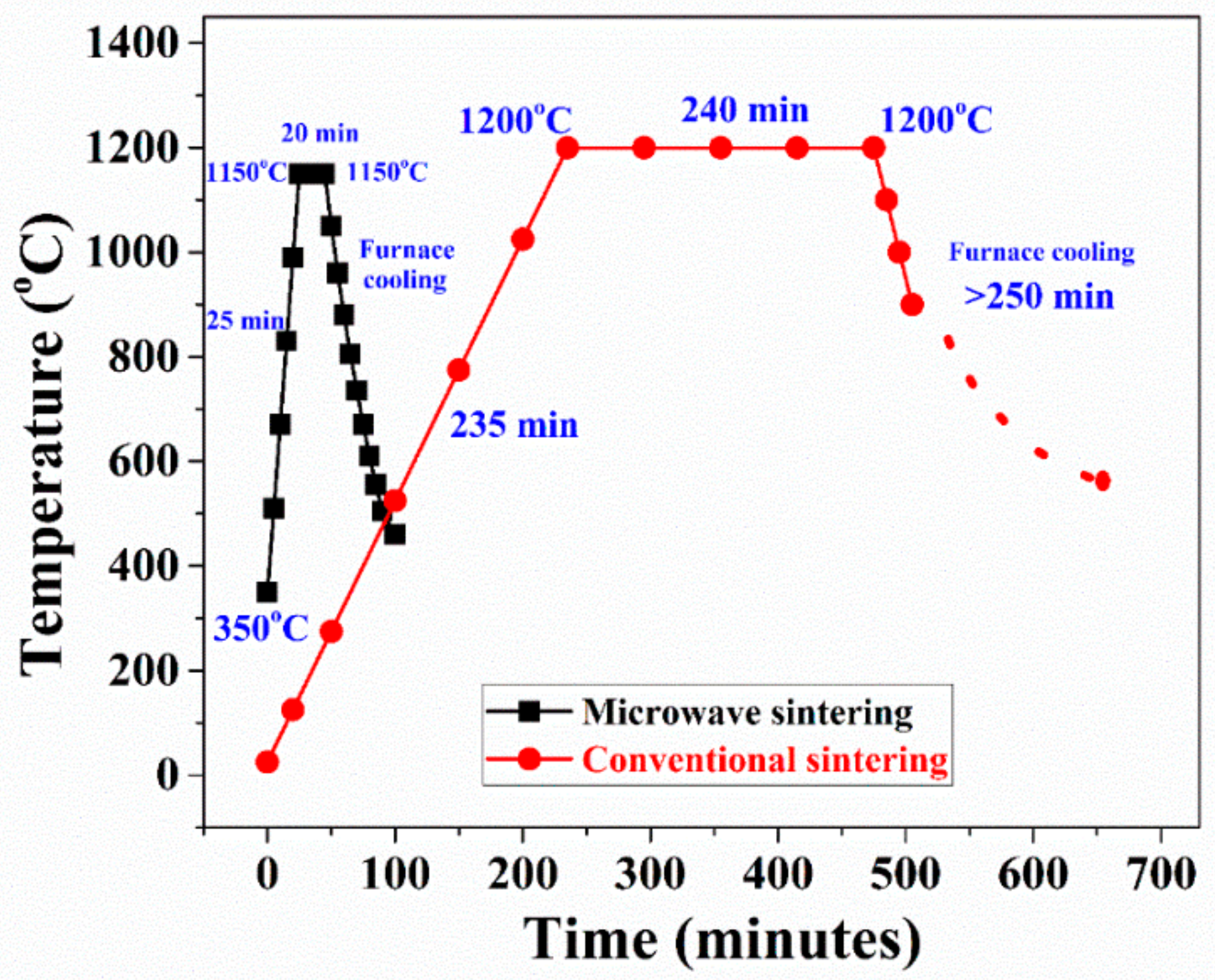
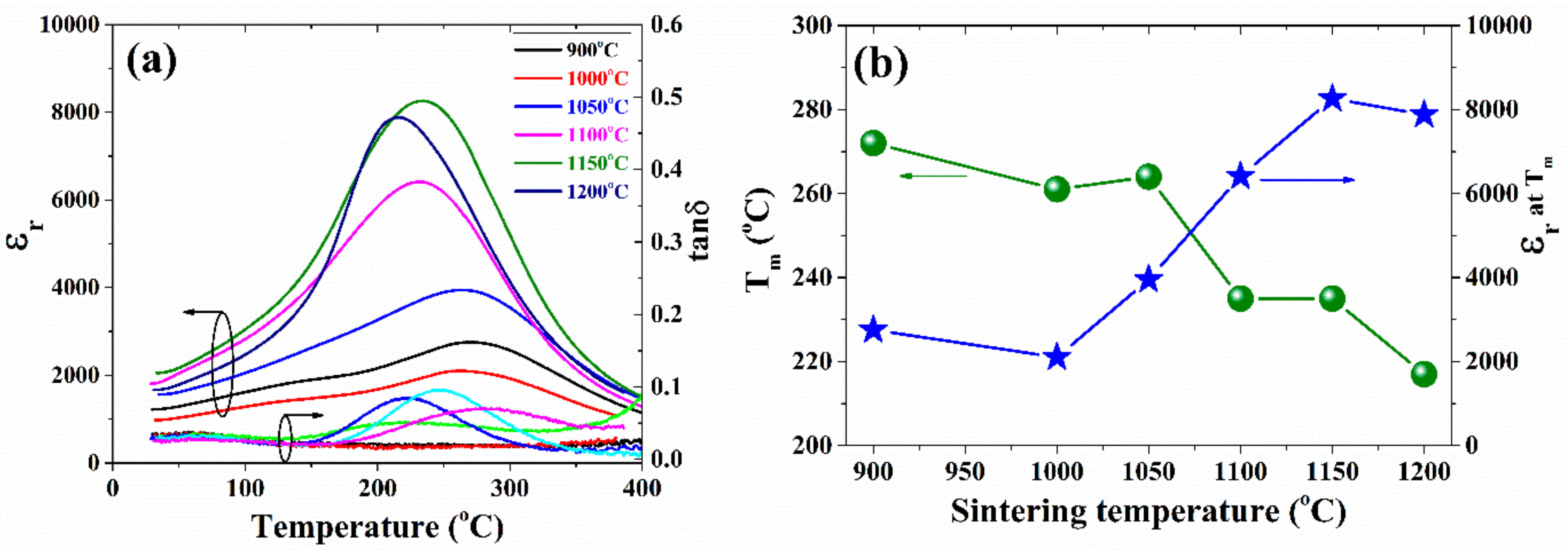
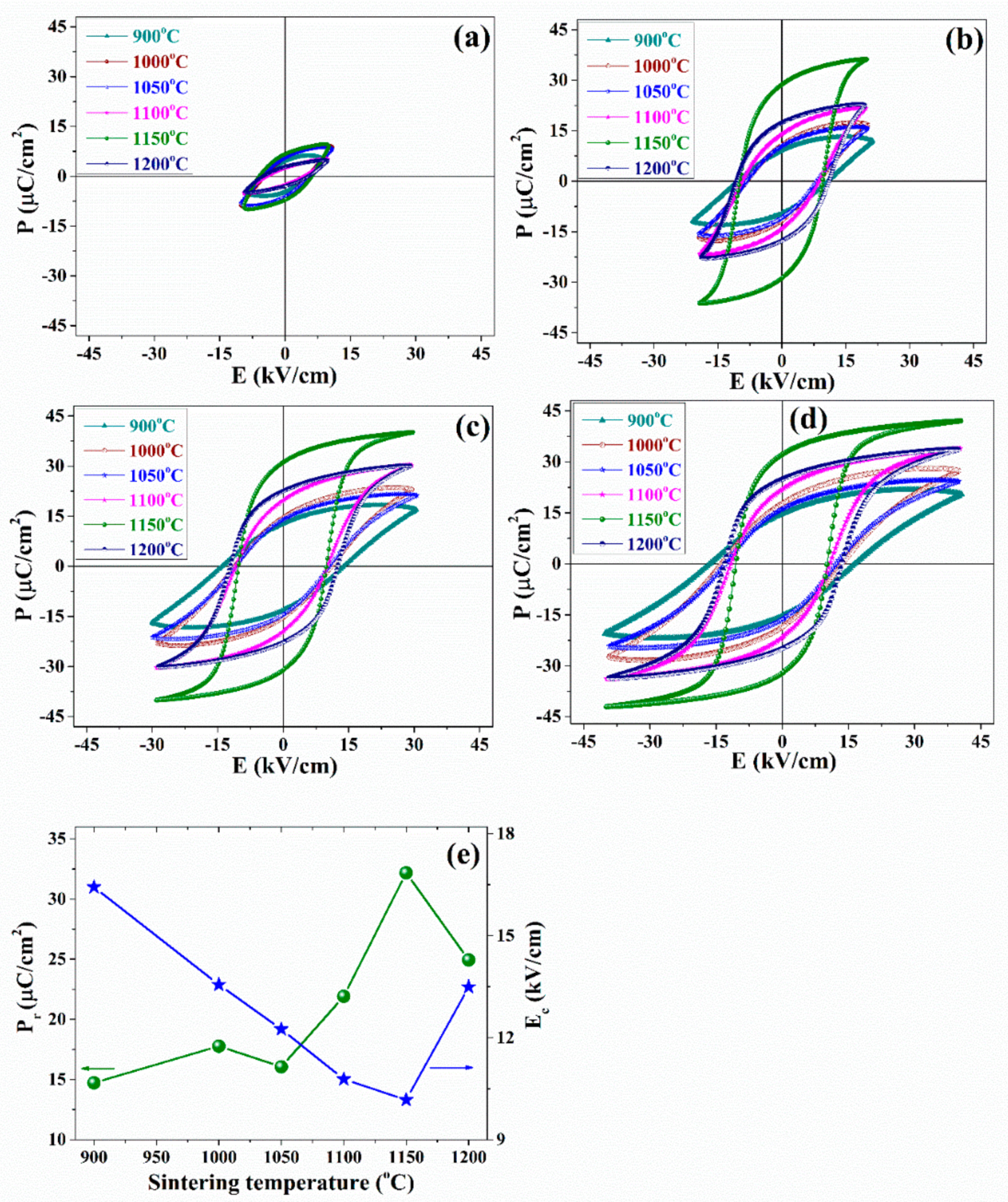

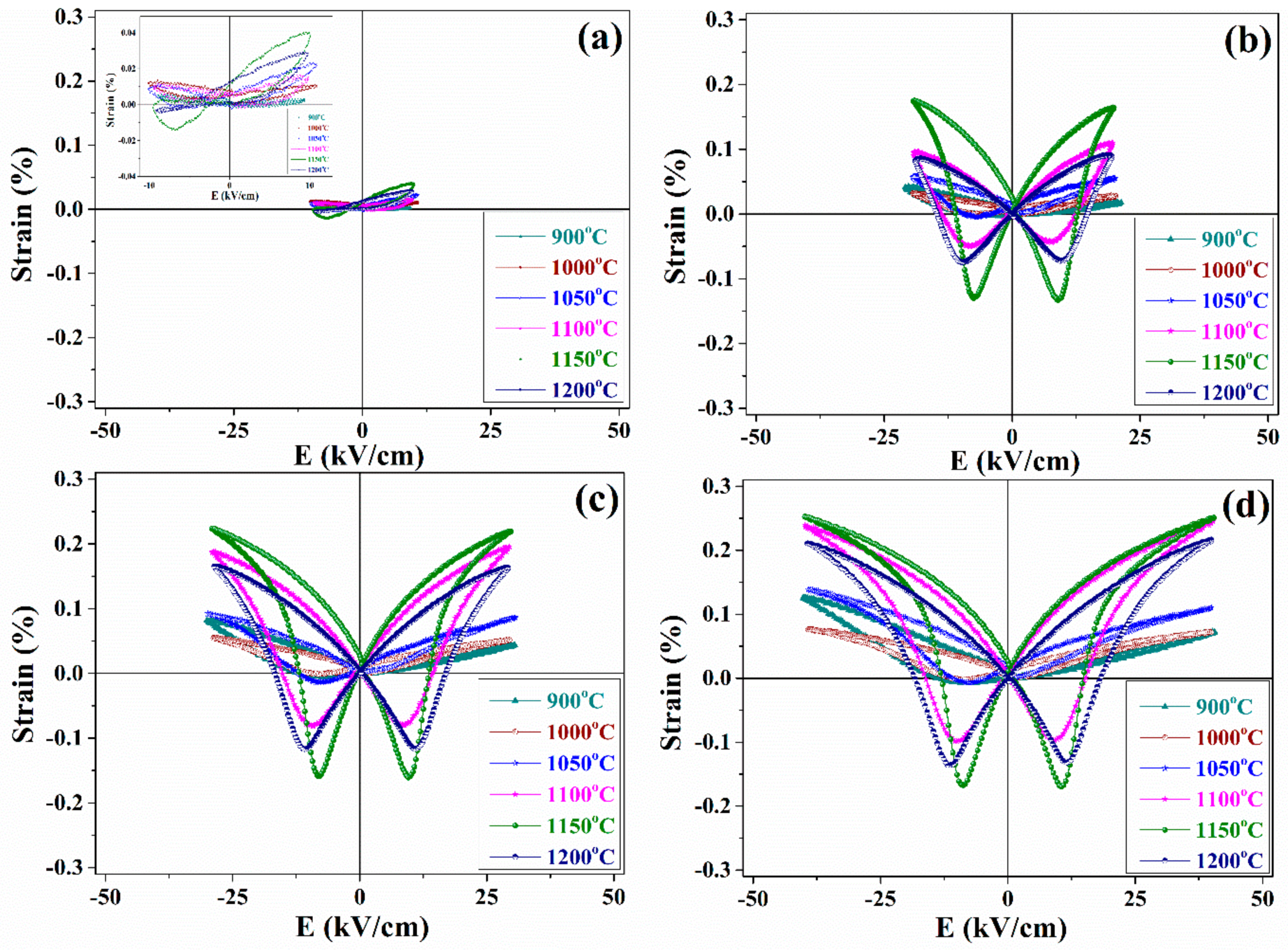

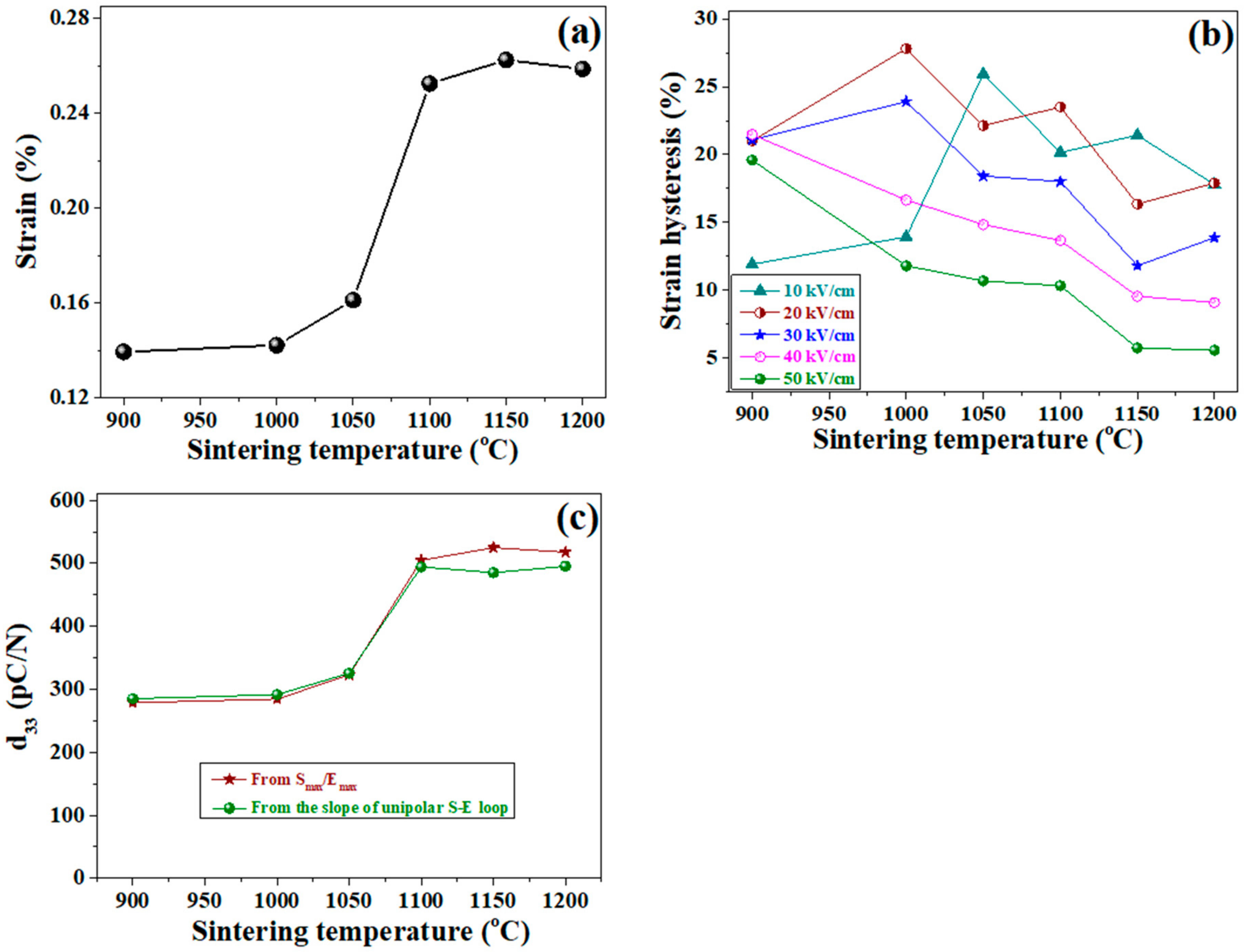
| Sintering Temperature (°C) | Grain Size (nm) | ρ (gm/cm3) | ρ (%) | εr at RT | εm at RT |
|---|---|---|---|---|---|
| 900 | 485 | 6.75 | 84.39 | 1259 | 1644 |
| 1000 | 549 | 6.84 | 85.45 | 1618 | 2070 |
| 1050 | 606 | 7.01 | 87.56 | 1682 | 2068 |
| 1100 | 726 | 7.61 | 95.17 | 1922 | 2072 |
| 1150 | 1210 | 7.96 | 99.46 | 2100 | 2117 |
| 1200 | 1540 | 7.50 | 93.76 | 1697 | 1872 |
| 900 °C | 1000 °C | 1050 °C | 1100 °C | 1150 °C | 1200 °C | |
|---|---|---|---|---|---|---|
| Tm(°C) | 272 | 261 | 264 | 235 | 235 | 217 |
| εr at Tm | 2753 | 2100 | 3950 | 6410 | 8260 | 7880 |
| ΔTdiff (°C) | 83 | 43 | 36 | 27 | 30 | 28 |
| Tcw (°C) | 355 | 338 | 357 | 344 | 370 | 366 |
| ΔTm (°C) | 83 | 77 | 93 | 109 | 135 | 149 |
| Sintering Temperature (°C) | Pr (μC/cm2) | Ec (kV/cm) | Imax (mA) | I at Emax (μA) | Wrec (mJ/cm3) | η (%) |
|---|---|---|---|---|---|---|
| 900 | 14.73 | 16.43 | 0.1327 | 70.68 | 60 | 10.60 |
| 1000 | 17.78 | 13.56 | 0.1879 | 71.43 | 107 | 15.47 |
| 1050 | 16.06 | 12.25 | 0.1981 | 50.34 | 90 | 15.76 |
| 1100 | 21.91 | 10.78 | 0.3677 | 22.83 | 153 | 24.50 |
| 1150 | 32.18 | 10.17 | 0.9074 | 13.63 | 123 | 19.67 |
| 1200 | 24.94 | 13.49 | 0.4512 | 31.80 | 117 | 16.84 |
| S. No. | Ceramics | Sintering Temperature (°C)/time | Wrec (mJ/cm3) | η (%) | Ref. |
|---|---|---|---|---|---|
| 1 | (Pb0.92La0.08) (Zr0.60Ti0.40) O3 | 1100/20 min | 153 | 24.50 | This study |
| 2 | (Pb0.92La0.08) (Zr0.60Ti0.40) O3 | 1150/20 min | 123 | 19.67 | This study |
| 3 | Pb0.97La0.02(Zr0.52Ti0.48) O3 | 1200/45 min | 59 | 24.00 | [55] |
| 4 | Pb0.92La0.08(Zr0.60Ti0.40)3.96 (Nb0.5Fe0.5)0.04 O3 | 1200/45 min | 134 | 28.00 | [55] |
| 5 | Pb0.92La0.08(Zr0.60Ti0.40)3.84 (Nb0.5Fe0.5)0.16O3 | 1200/45 min | 38 | 0.14 | [55] |
| 6 | (Pb0.895La0.07) (Zr0.65Ti0.35) O3 | 1200/45 min | 41 | 21.71 | [56] |
| 7 | (Pb0.865La0.09) (Zr0.60Ti0.40) O3 | 1200/45 min | 55 | 31.28 | [56] |
| 8 | (Pb0.98La0.02) (Zr0.90Ti0.10) O3 | 1250/240 min | 760 | 77.00 | [57] |
| 9 | (Pb0.92La0.08) (Zr0.60Ti0.40) O3 | 1200/240 min | 120 | 22.11 | [58] |
| Sintering Temperature (°C) | Strain (%) | Strain Hysteresis (%) | d33 (pm/V) | Smax/Emax (pm/V) |
|---|---|---|---|---|
| 900 | 0.140 | 19.60 | 285 | 279 |
| 1000 | 0.142 | 11.80 | 292 | 285 |
| 1050 | 0.161 | 10.70 | 326 | 323 |
| 1100 | 0.252 | 10.34 | 494 | 505 |
| 1150 | 0.262 | 5.74 | 485 | 525 |
| 1200 | 0.259 | 5.58 | 495 | 518 |
| S. No. | Sintering Temperature (°C)/Time | ρ (%) | Grain Size (µm) | εr | tanδ | d33 (pC/N) | kp (%) | Pr (µC/cm2) | Ec (kV/cm) | Strain (%) | Strain Hysteresis (%) | Ref. |
|---|---|---|---|---|---|---|---|---|---|---|---|---|
| 1 | 1150/20 min | 99.5 * | 1.2 * | 2100 * | 0.03 * | 575 * | 67 * | 32.18 | 10.17 | 0.26 | 5.74 | This study |
| 2 | 1200/4 h | 98 | 1.5 | 2290 | 0.02 | 560 | 67 | 33.30 | 10.57 | 0.27 | 5 | [34] |
| 3 | 1200/4 h | - | ~10 | 500 | 0.03 | 543 | - | - | - | - | - | [64] |
| 4 | 1250/24 h | - | 2 | 1000 | 0.02 | 520 | 29 | - | - | - | - | [65,66] |
| 5 | 1300/2 h | 98 | 2.8 | 3413 | 0.07 | 569 | - | 21.90 | 6.65 | - | - | [67] |
| 6 | 1250/4 h | 93 | 2 | 3283 | 0.03 | 387 | 52 | 42 | 6.67 | - | - | [68] |
| 7 | 1200/2 h | - | - | 2785 | - | - | - | 20.5 | 9.98 | - | - | [69] |
| 8 | 1200/60 h | 97 | 4.6 | 600 | 0.06 | - | - | 6.20 | 5.29 | - | - | [70] |
| 9 | 1275/2 h | - | - | - | - | - | - | 8 | 6 | 0.006 | - | [71] |
Publisher’s Note: MDPI stays neutral with regard to jurisdictional claims in published maps and institutional affiliations. |
© 2020 by the authors. Licensee MDPI, Basel, Switzerland. This article is an open access article distributed under the terms and conditions of the Creative Commons Attribution (CC BY) license (http://creativecommons.org/licenses/by/4.0/).
Share and Cite
Kumar, A.; Emani, S.R.; James Raju, K.C.; Ryu, J.; James, A.R. Investigation of the Effects of Reduced Sintering Temperature on Dielectric, Ferroelectric and Energy Storage Properties of Microwave-Sintered PLZT 8/60/40 Ceramics. Energies 2020, 13, 6457. https://doi.org/10.3390/en13236457
Kumar A, Emani SR, James Raju KC, Ryu J, James AR. Investigation of the Effects of Reduced Sintering Temperature on Dielectric, Ferroelectric and Energy Storage Properties of Microwave-Sintered PLZT 8/60/40 Ceramics. Energies. 2020; 13(23):6457. https://doi.org/10.3390/en13236457
Chicago/Turabian StyleKumar, Ajeet, Sivanagi Reddy Emani, K. C. James Raju, Jungho Ryu, and A. R. James. 2020. "Investigation of the Effects of Reduced Sintering Temperature on Dielectric, Ferroelectric and Energy Storage Properties of Microwave-Sintered PLZT 8/60/40 Ceramics" Energies 13, no. 23: 6457. https://doi.org/10.3390/en13236457
APA StyleKumar, A., Emani, S. R., James Raju, K. C., Ryu, J., & James, A. R. (2020). Investigation of the Effects of Reduced Sintering Temperature on Dielectric, Ferroelectric and Energy Storage Properties of Microwave-Sintered PLZT 8/60/40 Ceramics. Energies, 13(23), 6457. https://doi.org/10.3390/en13236457




